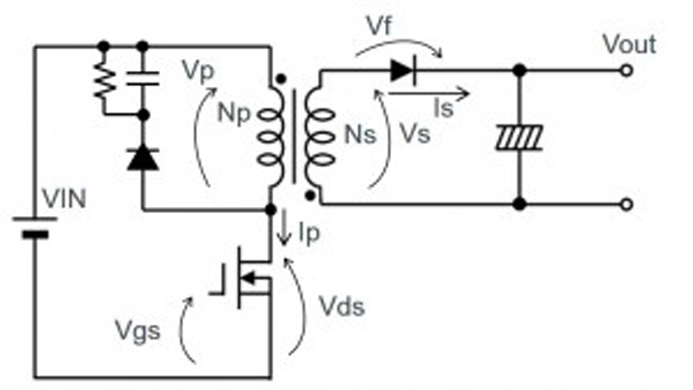What is a Flyback Converter
The flyback converter is a power supply topology that uses mutually coupled inductor, to store energy when current passes through and releasing the energy when the power is removed. The flyback converters are similar to the booster converters in architecture and performance. However, the primary winding of the transformer replaces inductor while the secondary provides the output. In the flyback configuration, the primary and secondary windings are utilized as two separate inductors.
Principle of operating of a flyback converter
When the current flowing through an inductor is cut off, the energy stored in the magnetic field is released by a sudden reversal of the terminal voltage. If a diode is in place to conduct the stored energy somewhere useful, the diode is called a flyback diode. This only requires one winding on the inductor, so the inductor would be called a flyback transformer. This arrangement has the interesting property of transferring energy to the secondary side of the power supply only when the primary switch is off.
The basic flyback converter uses a relatively small number of components. A switching device chops the input DC voltage and the energy in the primary is transferred to the secondary through the switching transformer. A diode in the secondary rectifies the voltage while the capacitor smoothes the rectified voltage. In a practical circuit, a feedback circuit is used to monitor the output voltage and while a control circuit switching device.
Operation of a PWM flyback converter in continuous mode
Figure 1 Basic circuit of a flyback converter – Image Credit
In a typical application, a switching device such as a transistor is turned on and off usually by a pulse-width-modulated signal. The transformer polarity is usually reversed such that when the transistor is on, current flows in the primary winding, however, the secondary diode is reverse biased and current does not flow in this winding. The energy is stored in the transformer until when the MOSFET is turned off. The stored energy produces a current that forward biases the diode which rectifies it to produce a DC output.
Advantages of flyback converter
- The primary is isolated from the output.
- Capable of supplying multiple output voltages, all isolated from the primary.
- Ability to regulate the multiple output voltages with a single control.
- Can operate on a wide range of input voltages
- The Flyback converters use very few components compared to the other types of SMPSs.
The Flyback transformer
The flyback transformer is more like two coupled inductors and therefore different from the conventional transformer. The flyback is designed to store energy while the conventional doesn’t. In addition, it operates at high frequencies of about 50 kHz. Its core is usually made of ferrite and includes a non-magnetic air gap across which the energy is stored. The conventional transformer is made of an iron core.
For the transformer to store energy during the period the current is flowing in the primary and later transfer the energy to the secondary winding when the switching device is off, the two inductor coils must be magnetically coupled.
Considerations when designing the flyback converter
The turn’s ratio influences the peak primary and secondary currents as well as the duty cycle. For example, when the turns ratio is low, the duty cycle is shorter and the current in the primary winding will increase.
The transformers are usually custom made since it is not possible to get perfect turns ratio in the market. When it is difficult to obtain a perfect transformer with the required transformer turns ratio, the best thing is to start by looking for the available transformers and choose what is closer to the desired ratings. This is then followed by choosing the other components in a way to compensate the slight difference that the transformer may introduce between say the required voltage and the transformer output.
Applications of flyback converters
The flyback converter are used for a wide range of electronics applications such as:
- Television sets which consume small amount of power of up to about 250W
- Standby power supplies for computers
- Cell phone and mobile device chargers
- High-voltage supplies in TV and Monitor CRTs, Lasers, Xenon flashlights, copiers, etc.
